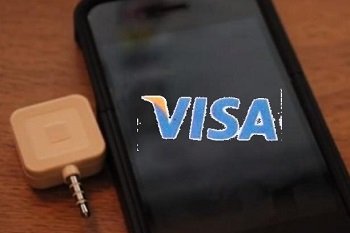The credit card company recently purchased a considerable amount of the company ahead of its IPO.
Visa Inc. has now taken a considerable stake in the Square Inc. mobile payments company, through shares purchased ahead of the initial public offering (IPO) at Square, according to a Security and Exchange Commission regulatory filing.
The financial services and credit card giant had purchased 4.19 million Class B shares back in 2011.
Those Class B shares do not trade publicly. That said, Square has revealed in its filing that Visa has the right to translate 3.52 million of those Class Bs into Class A shares. Should Visa choose to take advantage of that option, it would hold a 10 percent share of the mobile payments company. That would be only slightly smaller than the current largest stakeholder, Capital Research and Management Co, which owns a 12.4 percent slice of the company. Capital Research and Management is a massive L.A.-based mutual fund company.
Square has been finding its experience as a publicly offered mobile payments business to be quite challenging.
 The company’s IPO was back in November, at $9 per share. During the first day of trading, it saw a rise of 45 percent. However, since that time, it has been gradually slipping downward.
The company’s IPO was back in November, at $9 per share. During the first day of trading, it saw a rise of 45 percent. However, since that time, it has been gradually slipping downward.
Square offers a plastic “dongle” that attaches to mobile phones and tablets in order to make it possible to accept credit card payments. This makes it possible for small businesses, restaurants, tiny retailers, and sellers at arts and crafts festivals and farmer’s markets the opportunity to receive payments through credit card swipes and mobile technology. The CEO at Square is Jack Dorsey, who is also well known for being the chief exec at Twitter.
Square makes its money by charging a payment processing fee. Before the November 2015 IPO, Square had reported that it experienced $154 million in losses during 2014, on $850 million in revenues.
Mobile payments are an exceptionally rapidly growing business and are arriving in a number of different forms. While some allow mobile devices to be converted into a kind of portable point of sale terminal, others transform a smartphone into a wallet that can be used on the consumer-side.
As its handset sales remain lower than the Canadian company had hoped, it has slashed 200 jobs.
The restructuring strategy at BlackBerry has been continuing and, on the heels of a job cut affecting 200 people, the struggling Canadian handset manufacturing is now directing its attention toward software.
The company barely has any mobile device models left on the market shelves and their sales simply aren’t cutting it.
Because of this, BlackBerry appears to be shifting its focus in order to send its resources in the direction of mobile apps for consumers and services for businesses – areas in which the company has managed to excel, over the years. The market share of global smartphone sales currently held by the Canadian mobile device maker is a measly 0.3 percent (as of the third quarter of 2015), according to data from Gartner. That said, when it comes to business security software and other forms of applications, the brand is managing to steadily improve its position.
Even the switch that BlackBerry made to Android does not appear to have been enough to boost its smartphone sales.
 John Chen, CEO of the company, announced that the company didn’t intend to step away from hardware and, as a part of that strategy, the company released the Priv smartphone, which was based on Android instead of on its own proprietary operating system. The hope was that the more popular mobile platform, in combination with the exponentially larger availability of mobile apps, would be enough to draw consumers back to the brand. Unfortunately, while it did see an increase in sales, it doesn’t look as though it was enough to rescue its hardware business.
John Chen, CEO of the company, announced that the company didn’t intend to step away from hardware and, as a part of that strategy, the company released the Priv smartphone, which was based on Android instead of on its own proprietary operating system. The hope was that the more popular mobile platform, in combination with the exponentially larger availability of mobile apps, would be enough to draw consumers back to the brand. Unfortunately, while it did see an increase in sales, it doesn’t look as though it was enough to rescue its hardware business.
The device, itself, is quite unique, and it isn’t difficult to see why the company would feel that it had draw for consumers. Its large 5.4 inch touchscreen also offered a slide-out physical keyboard, for users who would prefer the ease of a mechanical way to type. Its 18 megapixel primary camera (which also allows for 4K video recordings) featured autofocus and an image stabilizer. It is NFC technology enabled and offers about 22 hours of battery with standard device usage. It also comes pre-loaded with security and privacy apps. Its retail US price is $699.
That said, while it doesn’t look like BlackBerry has reached the point where it is phasing its smartphones out of production, predictions look as though its hardware options are going to become slimmer as the year progresses.
 The company’s IPO was back in November, at $9 per share. During the first day of trading, it saw a rise of 45 percent. However, since that time, it has been gradually slipping downward.
The company’s IPO was back in November, at $9 per share. During the first day of trading, it saw a rise of 45 percent. However, since that time, it has been gradually slipping downward.
 John Chen, CEO of the company, announced that the company didn’t intend to step away from hardware and, as a part of that strategy, the company released the Priv smartphone, which was based on Android instead of on its own proprietary operating system. The hope was that the more popular mobile platform, in combination with the exponentially larger availability of mobile apps, would be enough to draw consumers back to the brand. Unfortunately, while it did see an increase in sales, it doesn’t look as though it was enough to rescue its hardware business.
John Chen, CEO of the company, announced that the company didn’t intend to step away from hardware and, as a part of that strategy, the company released the Priv smartphone, which was based on Android instead of on its own proprietary operating system. The hope was that the more popular mobile platform, in combination with the exponentially larger availability of mobile apps, would be enough to draw consumers back to the brand. Unfortunately, while it did see an increase in sales, it doesn’t look as though it was enough to rescue its hardware business.